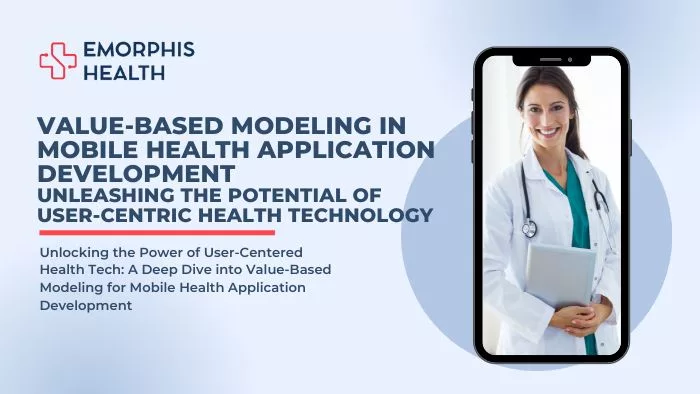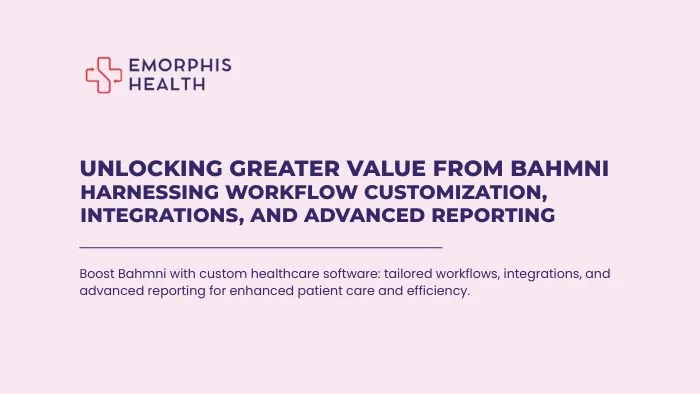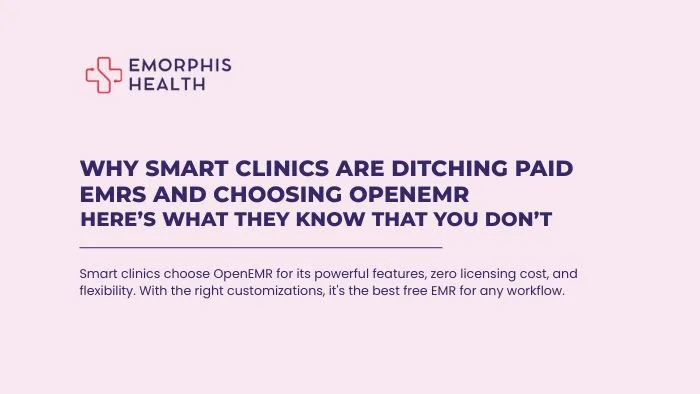Introduction
See Contents
- 1 Introduction
- 2 What Are The Types of Models in Value-based Modeling for Mobile Health Application Development?
- 3 An Example of a Healthcare Mobile App defined in the Various Value-based Models
- 4 How Can a Healthcare App Development Company Help in Achieving Value-based Models?
- 5 Who Should use These Value-based models?
- 6 Hire a Healthcare App Development Company
- 7 Future Technology with Value-based modeling for mobile health application development
- 8 How Emorphis Health can Help in Value-based Modeling for Mobile Health Application Development?
- 9 Value-based Modeling for Mobile Health Application Development
- 10 Conclusion
In an era where smartphones have become integral to our lives, their potential to revolutionize healthcare is increasingly evident. Mobile health applications have emerged as powerful tools for improving health outcomes and enhancing the quality of life. However, the key to creating truly impactful health apps lies not just in the technology they employ, but in the value they deliver to users.
Enter Value-based modeling – a strategic approach that shapes the development of mobile health apps around users’ needs, preferences, and aspirations.
In this article, we embark on a journey to explore the essence of Value-based modeling, dissect its components, and understand how it intertwines with the evolution of technology to shape the landscape of modern healthcare app development.
Join us as we uncover the principles, strategies, and real-world applications that make Value-based modeling a cornerstone in the pursuit of healthier lives through mobile health applications.
Definitions
Let’s break down “Value-based modeling for mobile health application development” in a simple way with examples:
Value-based
This means creating something useful and meaningful to people. Think of it as making something that helps others in some way.
Modeling
Imagine you want to build a toy car, but you’re not sure how it should look or work. So, you create a small version of the car using clay or blocks. This small version is a model. In the context of the topic, it means creating a plan or a design for the mobile health app before actually building it.
Mobile Health Application
This is like an app on your phone, like games or social media apps, but it’s focused on health. For example, an app that helps you track your steps reminds you to take your medication or even gives you tips on staying healthy.
Now, let’s put it all together
Value-based modeling for mobile health application development means planning to create a useful and meaningful health app for phones. It’s like drawing a blueprint of the app before actually building it. This blueprint helps the app creators understand how the app will work and make sure it’s helpful to people.

For instance, consider the scenario where you aim to develop a mobile app that assists individuals in staying hydrated by reminding them to drink water consistently throughout the day. In this case, you would analyze the essential functionalities that the app should encompass (such as setting up reminders and monitoring water consumption) as well as its visual design. This preparatory phase can be referred to as “value-based modeling.” Once the blueprint is finalized, you proceed to construct the app according to the devised plan. Ultimately, this results in an operational app that individuals can utilize to maintain their hydration.
In essence, “Value-based modeling for the development of mobile health applications” entails the creation of a deliberate strategy to craft health-oriented apps that genuinely benefit individuals. This strategy is then translated into a tangible app, accessible on mobile devices, which people can employ to enhance their well-being.
Check the details on Healthcare App Development services
What Are The Types of Models in Value-based Modeling for Mobile Health Application Development?
In value-based modeling for mobile health application development, there are a few types of models that help guide the process. These models provide different perspectives and insights to ensure the app is both valuable and effective. Let’s break down a couple of these types:
1. User Persona Models
Imagine you’re making an app to help people track their exercise. You create a “user persona” which is like a fictional character that represents a typical user of your app. This persona might be named “Active Annie,” and she’s a working professional who wants to stay fit despite her busy schedule. You think about Annie’s goals, needs, challenges, and preferences. This helps you design the app’s features to suit her, making it more valuable to someone like her.
2. User Journey Models
This type of model follows a user’s path through your app, step by step. For example, when someone opens your health app for the first time, what do they see? What do they do next? Do they set up their profile, input their health goals, or start tracking their activities? Mapping out these steps helps you understand the user experience and identify areas where the app can add value and be more user-friendly.
3. Wireframe Models
A wireframe is like a rough sketch of what the app’s screens will look like. It doesn’t focus on colors or fancy designs; it’s more about the layout and functionality. For instance, you might create a wireframe to show where the “Log Activity” button goes on the home screen and how the data will be displayed when a user checks their progress. This helps you visualize the app’s structure and ensure that the important features are prominently placed.
4. Flowchart Models
Think of a flowchart as a visual roadmap of how the app works. It shows the different paths a user can take within the app. For instance, in your health app, you might have a flowchart that illustrates how a user can navigate from setting a goal to tracking their progress and receiving reminders. This model helps you understand the logical flow of the app and ensures that users can achieve their goals seamlessly.
5. Value Proposition Models
This model focuses on what makes your app valuable to users. It involves identifying the unique benefits your app offers and how it addresses users’ needs. For example, your health app might emphasize features like personalized workout plans, easy-to-understand health insights, and motivational reminders. By highlighting these values, you can better communicate why users should choose your app over others.
These types of models work together to guide the creation of a mobile health app that truly brings value to users’ lives. Each model helps app developers understand their users, plan out the app’s functionality, and make sure it’s designed to provide a positive and helpful experience.
An Example of a Healthcare Mobile App defined in the Various Value-based Models
Let’s consider a “Medication Reminder” mobile health app as an example. This app helps users manage their medication schedules and ensures they take their prescribed medications on time. We’ll explain how this app could be developed using the various models mentioned earlier.
a. User Persona Model
User Persona – “Medication Mary”
Mary is a 60-year-old retiree who takes multiple medications for various health conditions. She sometimes forgets to take her pills at the right time, leading to disruptions in her treatment. The app developers create a user persona based on Mary’s profile, focusing on her needs, challenges, and preferences.
b. User Journey Model
Mary’s Journey Through the App
- Mary downloads the app and opens it for the first time.
- She is guided through a setup process where she enters her medication details and schedules.
- The app creates a personalized medication plan for Mary.
- Each day, Mary receives reminders to take her medications.
- If she forgets to take a dose, the app sends additional reminders or notifications.
- Mary can mark her doses as taken in the app.
- The app provides a history of her medication adherence.
c. Wireframe Model
The wireframe shows the app’s main screens, such as:
- Home screen: Displays the upcoming doses, the current day’s schedule, and a button to access the medication list.
- Medication list screen: Lists all the medications, dosages, and schedules.
- Reminder screen: Shows detailed reminders for each medication, including the medication name, dosage, and time.
d. Flowchart Model
The flowchart illustrates the app’s process:
- User opens the app -> Set up medication details -> App generates medication plan -> App sends reminders -> User marks doses as taken -> App maintains medication history.
e. Value Proposition Model
The app’s value proposition:
- Personalized medication schedules tailored to each user’s needs.
- Timely reminders to ensure medication adherence.
- Enhancing health management through historical tracking.
- Elevated treatment results and enhanced quality of life.
How Can a Healthcare App Development Company Help in Achieving Value-based Models?
If a healthcare app is already published but isn’t achieving its intended value, a Healthcare App Development services can still help in several ways to align the app with value-based models and enhance its impact. Here’s how:
User Experience Evaluation
The development company can conduct thorough user experience (UX) evaluations. They analyze user feedback, reviews, and usage patterns to identify pain points and areas of improvement within the app’s current design and functionality.
User Feedback Integration
Based on user feedback, the company can implement necessary changes to the app’s features, navigation, and overall usability. This can involve updating the app’s interface, optimizing workflows, and refining user interactions.
Feature Enhancement
If certain features are underutilized or not meeting user needs, the development company can work on enhancing or redesigning these features to provide more value. For instance, they can improve the medication reminder system, incorporate additional tracking capabilities, or introduce new health-related features.
Performance Optimization
Slow performance or technical issues can frustrate users and hinder the app’s value. The development company can optimize the app’s performance, ensuring that it loads quickly, operates smoothly, and doesn’t crash.
Personalization Strategies
Leveraging user data and preferences, the company can introduce personalization features that tailor the app experience to individual users. For example, they could offer customizable reminders, health goals, and content recommendations.
Behavioral Design
Using insights from behavioral psychology, the company can implement strategies to encourage consistent app usage and adherence to health goals. This might involve employing motivational techniques, rewards, and positive reinforcement within the app.
Analytics and Insights
The development company can integrate analytics tools into the app to gather data on user behavior, interactions, and usage patterns. This data can provide valuable insights for further app refinement and strategic decision-making.
Iterative Development
Through iterative development cycles, the company continuously monitors the app’s performance and user feedback, making incremental updates and improvements to ensure the app evolves in alignment with value-based models.
Data Security and Compliance
Ensuring the app’s compliance with data security regulations and healthcare standards is crucial. The development company can conduct audits and updates to ensure the app maintains high standards of data privacy and security.
Strategic Marketing and Communication
The company can work on enhancing the app’s visibility through strategic marketing efforts. They can refine the value proposition messaging and develop targeted campaigns to reach potential users who could benefit from the app.
In summary, even if a healthcare app is already published but not achieving its intended value, a healthcare app development company can apply its expertise to assess, improve, and align the app with value-based models. By addressing user needs, optimizing functionality, and enhancing the user experience, the app can be transformed into a more valuable tool for users’ health and wellness.
Who Should use These Value-based models?
Various stakeholders in mobile health app development employ these models. Let’s delve into the roles they play:
- App Designers, responsible for visuals, utilize user persona, wireframe, and flowchart models.
- Health App Developers translate designs into code, referencing wireframes and flowchart models for cohesion.
- Product Managers oversee using user journey and value proposition models.
- Marketing Teams leverage value proposition models to craft compelling campaigns.
- User Researchers gather insights via precise user persona models.
- Quality Assurance/Testers ensure functionality aligns with wireframe and flowchart models.
- Stakeholders and Healthcare Investors grasp concepts and potential value using these models.
Hire a Healthcare App Development Company
A healthcare app development company specializes in creating mobile applications focused on improving health and wellness. Here’s how they can assist with the “Medication Reminder” app
- Expertise: The company has experienced designers, developers, and researchers who understand the complexities of healthcare app development.
- User-Centric Approach: They conduct user research to create accurate user personas like “Medication Mary.” This ensures that the app is tailored to the needs and preferences of the target users.
- Design and Development: Using wireframe and flowchart models, they design the app’s interface and functionality, considering user interactions and seamless navigation.
- Testing and Quality Assurance: They rigorously test the app to ensure that reminders, notifications, and medication tracking work reliably.
- Regulatory Compliance: Healthcare apps often have regulatory requirements. The company ensures the app meets relevant healthcare standards and data security regulations.
- Value Enhancement: By using value proposition models, the company highlights the app’s unique benefits and features in marketing materials, making it attractive to potential users.
In summary, a healthcare app development company takes the concept of a healthcare app, like the “Medication Reminder” app, and turns it into a well-designed, user-friendly, and valuable solution that addresses users’ health needs effectively. They use various models to guide the development process and ensure the app’s success.
Future Technology with Value-based modeling for mobile health application development
Let’s explore how future technology can be combined with value-based modeling for the development of a medication reminder app. Imagine a scenario where advanced technologies enhance the app’s capabilities to provide even more value to users:
a. AIML
The medication reminder app could incorporate AI and ML algorithms to analyze a user’s medication history, health condition, and lifestyle patterns. It could learn from these data points and predict the most effective times for medication reminders based on when the user is most likely to adhere to their schedule. For instance, the app might recognize that a user tends to be more active in the morning and send reminders during those times.
Technology Features: AI algorithms analyze user behavior, medication history, and lifestyle patterns. ML predicts optimal medication reminder times.
Benefits: Personalized reminders enhance adherence. ML-driven insights improve reminder accuracy. AI-driven adaptive scheduling considers user preferences and behavior.
b. Smart Wearables and IoT Integration
Future iterations of the app could sync with smart wearable devices like smartwatches or fitness trackers. These wearables could monitor the user’s heart rate, activity level, and sleep patterns. If the wearable detects that the user’s heart rate is elevated or they are awake during the night, the app could adjust reminder timings accordingly. For example, it might delay a morning reminder if the user had a restless night’s sleep.
Technology Features: Sync with smartwatches/fitness trackers. Monitor heart rate, sleep patterns, and activity levels.
Benefits: Data-driven reminders synced with the user’s health status. Adherence aligned with the user’s physical state. Real-time monitoring enhances health insights.
c. Voice Recognition and Natural Language Processing
The app could integrate voice recognition and natural language processing capabilities. Users could verbally interact with the app to confirm medication intake or ask questions about their medications. The app could respond with personalized information and guidance, making the interaction more intuitive and user-friendly.
Technology Features: Users interact through voice commands. NLP understands and processes spoken language.
Benefits: Intuitive communication. Quick confirmation of medication intake. Instant answers to medication-related queries.
d. Predictive Health Insights
Leveraging data analytics and future technologies, the app could provide predictive health insights. For instance, if the app notices a consistent pattern of missed doses, it could give proactive suggestions, such as adjusting medication timings or offering motivational messages to improve adherence.
Technology Features: Data analytics predict adherence patterns. AI detects missed dose trends.
Benefits: Proactive suggestions improve adherence and early detection of adherence issues. Targeted interventions enhance health outcomes.
e. Virtual Health Assistants
Future iterations of the app might feature virtual health assistants powered by AI. These assistants could engage in conversations with users, reminding them of doses, answering queries, and providing information about potential interactions between medications and food. The AI could simulate human-like interactions and adapt its responses based on individual user preferences.
Technology Features: AI-powered virtual assistants simulate human-like interactions.
Benefits: Engaging conversations. Timely reminders. Personalized guidance based on user queries.
f. Augmented Reality (AR) Reminders
With AR technology, the app could project visual reminders directly onto the user’s environment. For example, as the user approaches their medicine cabinet, the app might use AR to overlay a reminder to take their medication. This immersive reminder experience could enhance user engagement and adherence.
Technology Features: AR overlays visual reminders in the user’s environment.
Benefits: Immersive reminders that enhance user engagement. Timely prompts in the user’s physical context.
How Emorphis Health can Help in Value-based Modeling for Mobile Health Application Development?
At Emorphis Health, we are at the forefront of healthcare app development, specializing in the seamless integration of cutting-edge technologies such as Artificial Intelligence (AI), Machine Learning (ML), Augmented Reality (AR), and Internet of Things (IoT) into app frameworks. Our user-centric approach ensures the incorporation of these technologies while prioritizing the user experience. Our team of skilled professionals crafts sophisticated AI algorithms that analyze user behavior and health data, enabling the delivery of personalized insights and reminders that enhance medication adherence. We design intuitive interfaces tailored for wearables and AR interactions, ensuring a smooth and engaging user journey.
Committed to data security, we ensure strict compliance with regulatory standards, safeguarding sensitive health information. Leveraging our profound understanding of both technology and healthcare, our marketing efforts spotlight the app’s innovative features and advanced technologies that set it apart. In this forward-looking perspective, value-based modeling remains our guiding principle, ensuring that these technological advancements harmonize with user needs, elevate the app’s value proposition, and significantly contribute to improved health outcomes.
Value-based Modeling for Mobile Health Application Development
Emorphis Health plays a pivotal role in advancing Value-based modeling for mobile health application development through our expertise and approach. As a healthcare app development company, we bring together our technological prowess and commitment to user-centered design to create apps that resonate with users’ needs and deliver tangible value.
Here’s how we contribute
a. Integration of Cutting-edge Technologies
We harness advanced technologies like AI, ML, AR, and IoT to create innovative and personalized app experiences. By infusing these technologies, we align the app’s features with user expectations, thus fulfilling the value that users seek.
b. User-Centric Design
Our emphasis on the user experience ensures that our apps are not only technologically advanced but also user-friendly and intuitive. We create interfaces that make it easy for users to engage with the app’s features, enhancing the overall value they derive.
c. Personalized Insights and Engagement
Leveraging AI algorithms, we provide users with personalized insights and reminders that encourage adherence to health goals. This level of personalization enhances user engagement and the app’s perceived value.
d. Seamless User Interaction
We design interfaces for wearables and AR interactions that streamline user engagement. These interfaces ensure that users can seamlessly integrate wearable data and interact with AR features, adding a new dimension to their app experience.
e. Data Security and Compliance
Our dedication to data security ensures that sensitive health information is handled with the utmost care and in compliance with regulatory standards. This instills trust in users and adds to the perceived value of the app.
f. Emphasis on Innovation
Through our marketing endeavors, we highlight the innovative features and advanced technologies within the app. By showcasing the app’s unique value proposition, we attract users who seek cutting-edge solutions for their health needs.
g. Alignment with Value-based Models
Our approach aligns with value-based models by ensuring that technological enhancements directly translate into improved user experiences and health outcomes. We continually refine our development process to keep user needs at the core, thus maintaining a solid connection to value-based principles.
In essence, Emorphis Health acts as a bridge between the potential of advanced technologies and the realization of value in mobile health applications. Our commitment to enhancing user experiences, integrating innovations, and adhering to the principles of value-based modeling positions us as a partner dedicated to creating apps that truly make a positive impact on users’ health and well-being.
Conclusion
In the realm of mobile health application development, the concept of Value-based modeling stands as a guiding beacon, directing the creation of apps that resonate with user needs, offer meaningful solutions, and contribute to improved health outcomes. This approach transcends the mere development of technology; it is an intricate interplay between understanding user personas, crafting personalized user journeys, and integrating cutting-edge technologies to enhance value delivery.
By embracing Value-based modeling, healthcare app development companies ensure that every feature, interaction, and innovation aligns with the broader goal of improving users’ health and well-being. As technology evolves and user expectations shift, this model remains a steadfast pillar, anchoring the development process in principles that prioritize user-centric design, personalized experiences, and the profound impact that a well-crafted health application can have on individuals’ lives.
In essence, Value-based modeling empowers developers to bridge the gap between technological capabilities and genuine value, resulting in applications that not only meet users’ needs but elevate their health journey to new heights.










